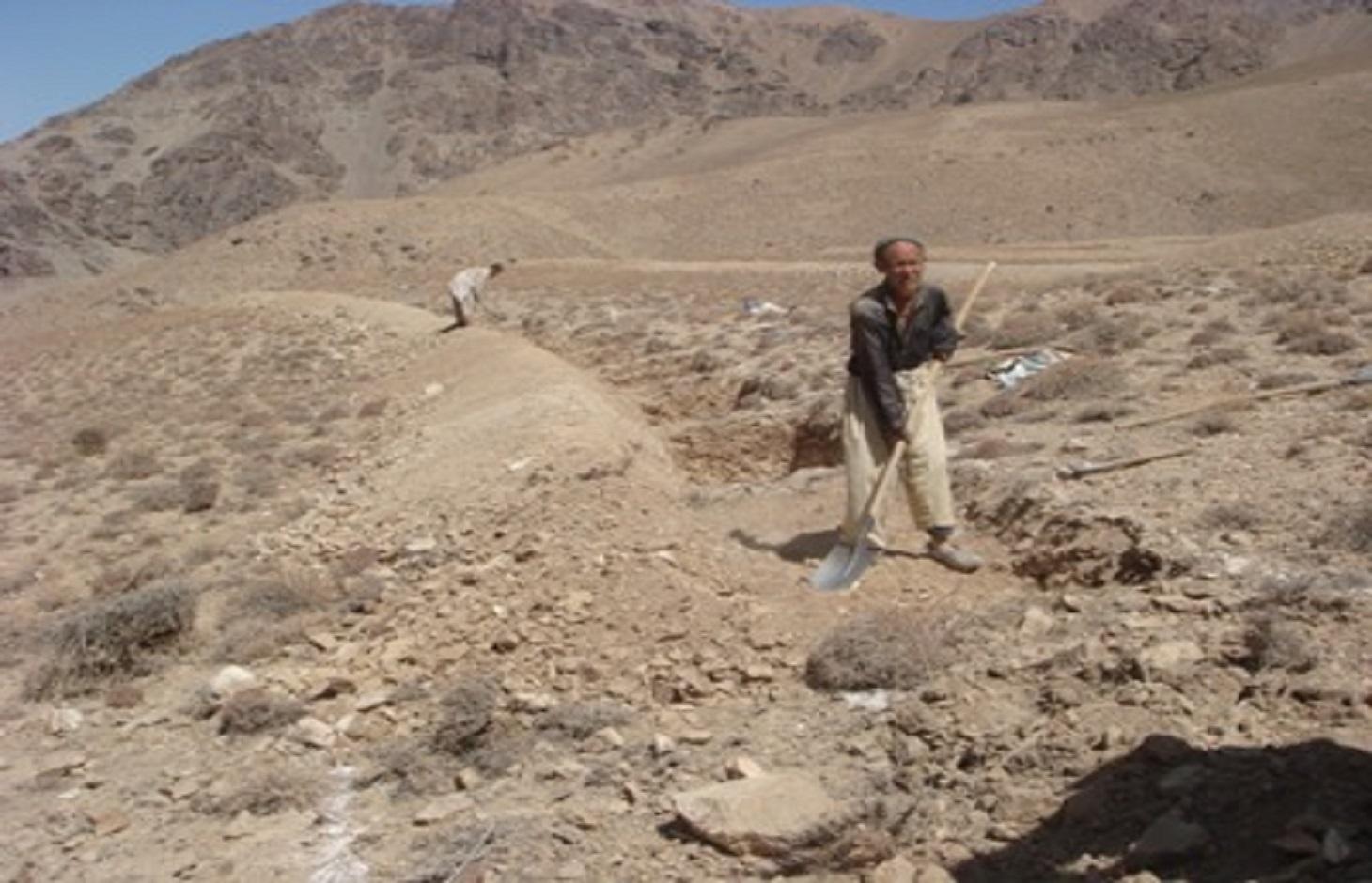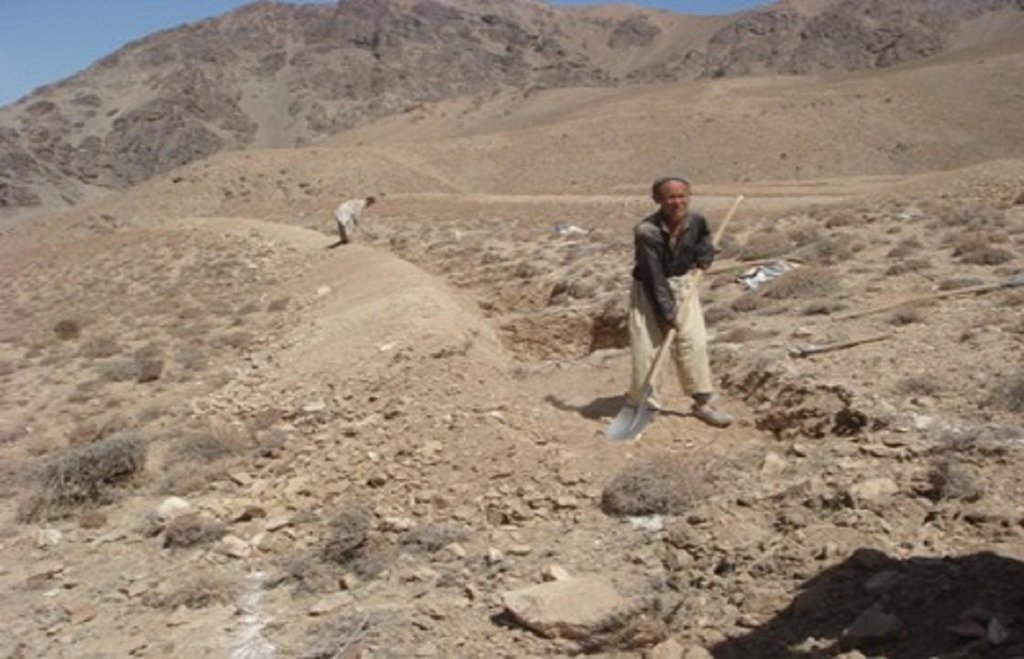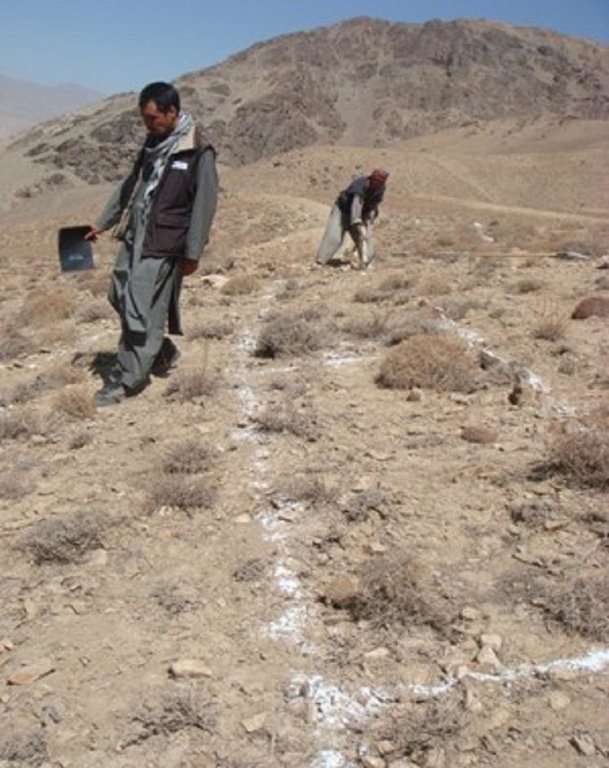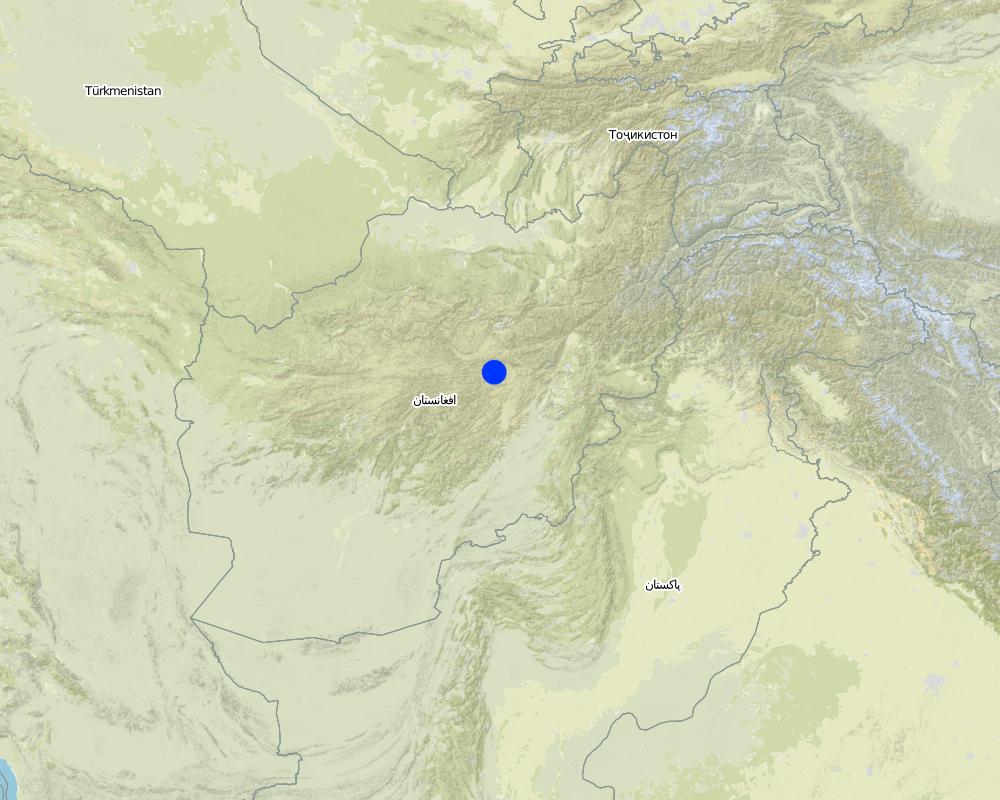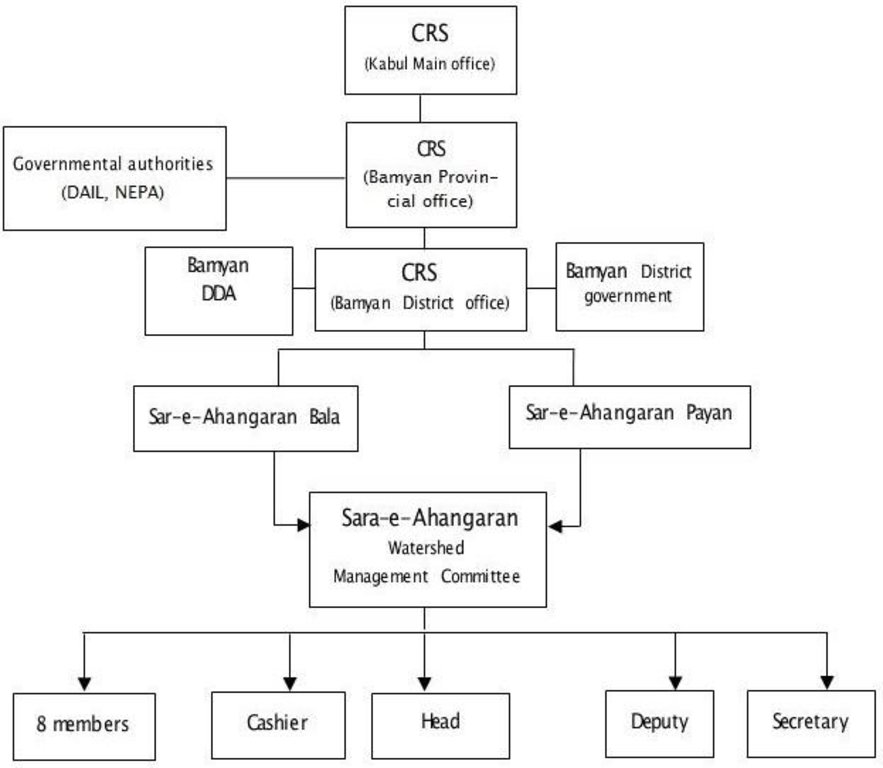Community-Based Watershed Management [Afganistán]
- Creación:
- Actualización:
- Compilador: Aqila Haidery
- Editor: –
- Revisor: Deborah Niggli
Mudiriat Aabreza Tawasut Mardum (Dari)
approaches_2612 - Afganistán
Visualizar secciones
Expandir todo Colapsar todos1. Información general
1.2 Detalles de contacto de las personas de referencia e instituciones involucradas en la evaluación y la documentación del Enfoque
Especialista MST:
Especialista MST:
Especialista MST:
Montzieux Mathilde
Afganistán
Especialista MST:
Hazem Zainullah
Afganistán
Especialista MST:
Alemi Saadat
Afganistán
Especialista MST:
Ershad Mustafa
Afganistán
Especialista MST:
Ahmadi Reza
Afganistán
Nombre de la(s) institución(es) que facilitaron la documentación/ evaluación del Enfoque si fuera relevante)
HELVETAS (Swiss Intercooperation)1.3 Condiciones referidas al uso de datos documentados mediante WOCAT
¿Cuándo se compilaron los datos (en el campo)?
10/11/2011
El compilador y la/s persona(s) de referencia claves aceptan las condiciones acerca del uso de los datos documentados mediante WOCAT :
Sí
1.4 Referencia/s al/los Cuestionario(s) de Tecnologías MST

Stone wall [Afganistán]
Contour stone walls constructed on moderate to steep slopes to retain water and sediments and trap snow.
- Compilador: Aqila Haidery
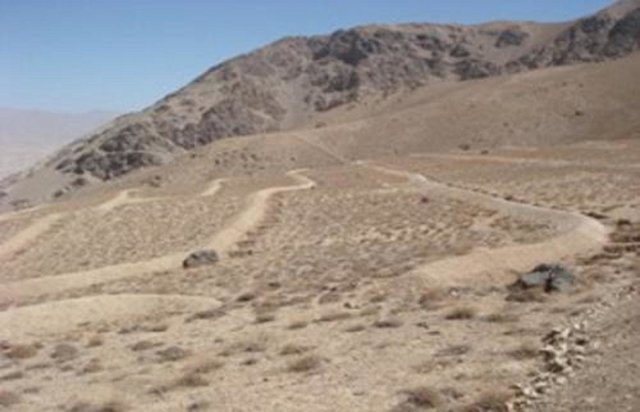
Contour Trench Bund [Afganistán]
Contour trench bund applied on contour lines of moderate slope to trap run-off to improve infiltration and reduce flash floods.
- Compilador: Aqila Haidery
2. Descripción del Enfoque MST
2.1 Breve descripción del Enfoque
Sustainable implementation of watershed management through appropriate SLM technologies, formation of organizational structures and capacity building of stakeholders
2.2 Descripción detallada del Enfoque MST
Descripción detallada del Enfoque MST:
The overall objective of the community-based watershed management project implemented at Sar-e-Ahangaran was to reduce water induced disaster risks and improve people’s livelihoods. The project was implemented by Catholic Relief Services (CRS) with people’s support and funding assistance from USAID.
About 67 hectares of degraded land has been rehabilitated since 2009 through various soil and water conservation measures like stone walls, contour trenches and plantation of fodder species such as alfalfa. The local communities are also protecting the treated areas from grazing and shrub cutting.
With facilitation from CRS, a 15-member watershed management committee was appointed by the participating families. This was important for organizing watershed related works and for the sustainability of project interventions. Some rules for managing the selected watershed were also formulated in a participatory way. For instance, if anyone is found grazing animals at the site, he has to give one sheep to the watershed committee as a fine.
CRS has provided training and technical support to the watershed committee members and workers for project implementation and monitoring. The daily workers were selected from the local communities by the watershed committee and paid in cash as per national norms for their labor. CRS also organized awareness raising workshops regarding environmental conservation and water-shed management and the entire community including teachers and students participated in these village events.
As a result of Sar-e-Ahangaran watershed management project, the people have a more positive attitude towards natural resource management. The formation and capacity building of the watershed management committee is a step towards ensuring long-term sustainability of the project outputs and community owner-ship. The watershed committee is not yet registered with the government but for future sustainability, this will be an important activity. The Islamic Republic of Afghanistan is in the process of formulating a comprehensive community-based natural resource management strategy. Once in place, the Sar-e-Ahangaran community can take advantage of that strategy if the watershed committee is formally registered with the Ministry of Agriculture, Irrigation and Livestock (Bamyan).
The Community-Based Watershed Management approach is documented by Sustainable Land Management Project /HELVETAS Swiss Intercooperation which is funded by Swiss Agency for Development and Cooperation with close support and cooperation of the Catholic Relief Service (CRS).
2.3 Fotos del Enfoque
2.5 País/ región/ lugares donde el Enfoque fue aplicado
País:
Afganistán
Región/ Estado/ Provincia:
Bamyan
Especifique más el lugar :
Sar-e-Ahangaran, Bamyan center
Map
×2.6 Fechas de inicio y conclusión del Enfoque
Indique año del inicio:
2009
2.7 Tipo de Enfoque
- proyecto/ basado en un programa
2.8 Propósitos/ objetivos principales del Enfoque
The Approach focused mainly on SLM with other activities (Disaster Risk Reduction, Rural Livelihoods Improvement)
The overall objective of the project was to reduce watershed induced disaster risks and improve rural livelihoods through SLM technologies and community based sustainable approaches
The SLM Approach addressed the following problems: Lack of people’s knowledge regarding sustainable management of natural resources and disaster risk reduction, lack of knowledge, technical and organisational capacities on sustainable land management technologies for degraded lands
2.9 Condiciones que facilitan o impiden la implementación de la/s Tecnología/s aplicadas bajo el Enfoque
normas y valores sociales/ culturales/ religiosos
- impiden
People did not have a good idea about how to conserve the environment and at the same time reduce disaster risks and improve their livelihoods
Treatment through the SLM Approach: Training and education via sharing knowledge with watershed committees in Waras forming maintenance committees who should look after restrictions about grazing. Practical demonstration of potential SLM technologies
disponibilidad/ acceso a recursos y servicios financieros
- impiden
People do not have financial capacities
Treatment through the SLM Approach: Project had a Cash for Work but learning approach
marco de trabajo legal (tenencia de tierra, derechos de uso de tierra y agua)
- impiden
As the land is formally owned by the government, people did not invest much in sustainable practices. During project initiation, people were also sceptical and rejected the project idea as they thought that by digging trenches, the project was trying to search for gold
Treatment through the SLM Approach: Through several discussions and clarifications and by assurances from the government, people were convinced that the project had no hidden motives and gradually their trust in CRS increased
conocimiento de MST, acceso a apoyo técnico
- impiden
Lack of knowledge about SLM measures
Treatment through the SLM Approach: Training and technical support from CRS
3. Participación y roles de las partes interesadas involucradas
3.1 Partes interesadas involucradas en el Enfoque y sus roles
- usuarios locales de tierras/ comunidades locales
- organizaciones comunitarias
3.2 Involucramiento de los usuarios locales de tierras/ comunidades locales en las distintas fases del Enfoque
| Involucramiento de los usuarios locales de tierras/ comunidades locales | Especifique quién se involucró y describa las actividades | |
|---|---|---|
| iniciación/ motivación | interactivo | CRS discussed land use problems and formulated the project. Project site was selected by the participating families and respective CDCs |
| planificación | interactivo | CDC and watershed members were involved in the planning but not the whole community |
| implementación | apoyo externo | Implementation was by the local communities with cash for work approach |
| monitoreo y evaluación | auto-movilización | Voluntary monitoring group to look after the environment. Also joint monitoring by project stakeholders |
| Research | pasivo |
3.3 Flujograma (si estuviera disponible)
Descripción:
The organizational Chart of Sar-e_Ahangaran Watershed Management Committee
Autor:
Catholic Relief Service (CRS)
3.4 La toma de decisiones en la selección de Tecnología(s) MST
Especifique quién decidió la selección de las Tecnología/ Tecnologías a implementarse:
- principalmente por especialistas MST en consulta con usuarios de tierras
Explique:
The area was selected by the community
Decisions on the method of implementing the SLM Technology were made by mainly by SLM specialists with consultation of land users. However, workers were selected by the watershed committee members in consultation with their community development councils (CDCs).
4. Apoyo técnico, fortalecimiento institucional y gestión del conocimiento
4.1 Construcción de capacidades / capacitación
¿Se proporcionó la capacitación a usuarios de tierras/ otras partes interesadas?
Sí
Especifique quién fue capacitado:
- usuarios de tierras
- Project field officers, Land users, CDC and Watershed Management Committee members, teacher and students, both women and men
Forma de capacitación:
- en el contexto de trabajo
- de agricultor a agricultor
Forma de capacitación:
- organizing courses
Temas avanzados:
contour trench and stone wall technologies, tree planting, importance of pasture management and watershed management
4.2 Servicio de asesoría
¿Los usuarios de tierras tienen acceso a un servicio de asesoría?
Sí
Describa/ comentarios:
CRS provided continuous advice; Key elements: increase awareness by forming a watershed committee, technical support of the committee
Advisory service is inadequate to ensure the continuation of land conservation activities; The government or other advisory service is still inadequate to ensure the continuation of land conservation activities. The government authorities visited the project only once, at the end of the project. They did not provide much support; however, as the land belongs formally to the state, they did not have any objections for applying watershed management measures.
4.3 Fortalecimiento institucional (desarrollo institucional)
¿Se establecieron o fortalecieron instituciones mediante el Enfoque?
- sí, moderadamente
Especifique el nivel o los niveles en los que se fortalecieron o establecieron las instituciones:
- local
Proporcione detalles adicionales:
CDCs and watershed management committees. Schools teachers and students also received training
4.4 Monitoreo y evaluación
¿El monitoreo y la evaluación forman parte del Enfoque?
Sí
Comentarios:
bio-physical aspects were regular monitored by project staff through measurements; indicators: Water quality and quantitative measurements
technical aspects were ad hoc monitored by project staff, land users, other through observations; indicators: ad hoc field visits and monitoring of structural quality
socio-cultural aspects were ad hoc monitored by project staff through measurements; indicators: Hosuehold survey
economic / production aspects were ad hoc monitored by project staff through measurements; indicators: Household survey
area treated aspects were ad hoc monitored by project staff through observations; indicators: Other areas where technology has been applied
no. of land users involved aspects were regular monitored by land users through measurements; indicators: Selecting the beneficiaries
management of Approach aspects were None monitored by land users through observations; indicators: Monitoring the community which looks after the pasture management
There were few changes in the Approach as a result of monitoring and evaluation: especially with regard to organisational structure for monitoring works
4.5 Investigación
¿La investigación formó parte del Enfoque?
Sí
- Farm research
Proporcione detalles adicionales e indique quién hizo la investigación:
Topics included technology functions, vegetation status before and after project, monitoring of spring (located below) water quality and quantity.
5. Financiamiento y apoyo material externo
5.1 Presupuesto anual para el componente MST del Enfoque
Si no se conoce el presupuesto anual preciso, indique el rango:
- 10,000-100,000
Comentarios (ej. fuentes principales de financiamiento/ donantes principales):
Approach costs were met by the following donors: international non-government: 99.0%; local community / land user(s): 1.0%
5.2 Apoyo financiero/material proporcionado a los usuarios de tierras
¿Los usuarios de tierras recibieron financiamiento/ apoyo material para implementar la Tecnología/ Tecnologías? :
No
5.4 Crédito
¿Se proporcionó crédito bajo el Enfoque para actividades MST?
No
5.5 Otros incentivos o instrumentos
¿Se usaron otros incentivos o instrumentos para promover la implementación de Tecnologías MST?
No
6. Análisis de impacto y comentarios de conclusión
6.1 Impactos del Enfoque
¿El Enfoque ayudó a los usuarios de tierras a implementar y mantener Tecnologías MST?
- No
- Sí, un poco
- Sí, moderadamente
- Sí, mucho
Land cover by vegetation improved significantly. Flash floods and snow avalanche problems were reduced, and the community members were more aware about the technologies and approaches for sustainable land management.
¿El Enfoque empoderó a grupos en desventaja social y económica?
- No
- Sí, un poco
- Sí, moderadamente
- Sí, mucho
People got cash for work and some of the families could pay back their loans through this income.
The land belongs to the state and the water use right is as well open access and and organized manner. In this particular land land use problem or water use problems have not been seen.
Did other land users / projects adopt the Approach?
- No
- Sí, un poco
- Sí, moderadamente
- Sí, mucho
There were constraints from the people in the beginning. Now a similar approach with some modifications is being implemented in other watersheds as well as a result of this project.
Did the Approach lead to improved livelihoods / human well-being?
- No
- Sí, un poco
- Sí, moderadamente
- Sí, mucho
They got more money via the cash for work; however, there is no impact for the livestock because the pasture area is big enough.
Did the Approach help to alleviate poverty?
- No
- Sí, un poco
- Sí, moderadamente
- Sí, mucho
due to cash for work approach and increased production of wheat, potato and other agricultural products as a result of reduced flood risks
6.2 Motivación principal del usuario de la tierra para implementar MST
- incremento de la renta(bilidad), proporción mejorada de costo-beneficio
- reglas y reglamentos (multas)/ aplicación
- to get employed through cash for work
- reduce flood risks
- Understand the importance of watershed
- Understand the importance of NRM
- Ownership of the project activities
6.3 Sostenibilidad de las actividades del Enfoque
¿Pueden los usuarios de tierras sostener lo que se implementó mediante el Enfoque (sin apoyo externo)?
- incierto
Si respondió no o incierto, especifique y comente:
but CRS continues to build capacities of watershed committees and support plantation of fodder species so that people get direct benefits and the project is sustained.
6.4 Fortalezas/ ventajas del Enfoque
| Fuerzas/ ventajas/ oportunidades desde la perspectiva del compilador o de otra persona de referencia clave |
|---|
| Less damage to some agricultural land located below the watershed sites due to flash floods |
| Prevention of snow slide |
| Increased water in the spring |
| Plant coverage of the area increased |
| Prevention from soil erosion |
6.5 Debilidades/ desventajas del Enfoque y formas de sobreponerse a ellos
| Debilidades/ desventajas/ riesgos desde la perspectiva del compilador o de otra persona de referencia clave | ¿Cómo sobreponerse a ellas? |
|---|---|
| Watershed management committee is not registered | CRS should facilitate registration of the committee with the Department of Agriculture, Irrigation and Livestock in Bamyan |
| People are not taking care of the plantations | People must understand the importance of plantations. The project should figure out the reasons why people are not interested in plantation activities and adjust approaches accordingly |
7. Referencias y vínculos
7.1 Métodos/ fuentes de información
- visitas de campo, encuestas de campo
- entrevistas con usuarios de tierras
Vínculos y módulos
Expandir todo Colapsar todosVínculos

Stone wall [Afganistán]
Contour stone walls constructed on moderate to steep slopes to retain water and sediments and trap snow.
- Compilador: Aqila Haidery

Contour Trench Bund [Afganistán]
Contour trench bund applied on contour lines of moderate slope to trap run-off to improve infiltration and reduce flash floods.
- Compilador: Aqila Haidery
Módulos
No se hallaron módulos


